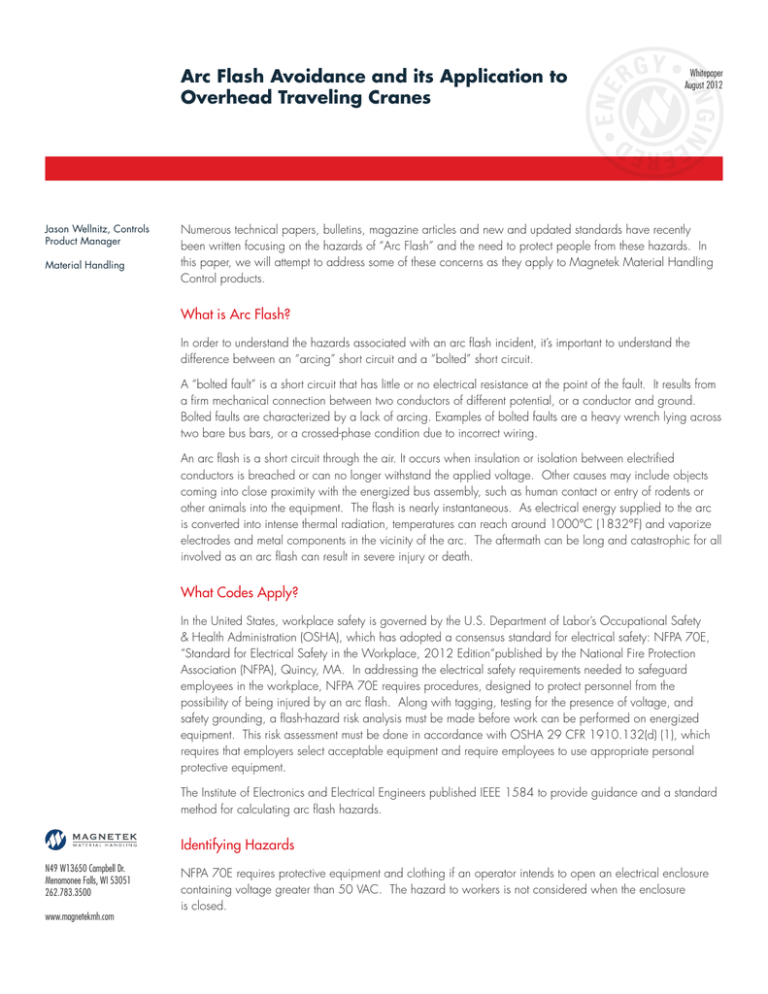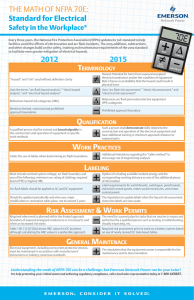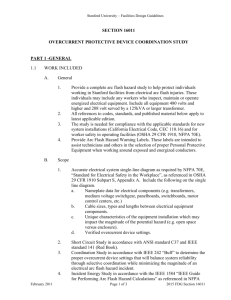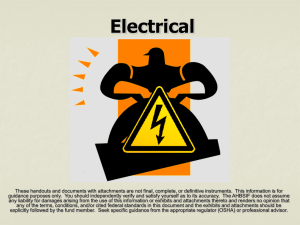Arc Flash Avoidance and its Application to Overhead Traveling Cranes
advertisement

Arc Flash Avoidance and its Application to Overhead Traveling Cranes Jason Wellnitz, Controls Product Manager Material Handling Whitepaper August 2012 Numerous technical papers, bulletins, magazine articles and new and updated standards have recently been written focusing on the hazards of “Arc Flash” and the need to protect people from these hazards. In this paper, we will attempt to address some of these concerns as they apply to Magnetek Material Handling Control products. What is Arc Flash? In order to understand the hazards associated with an arc flash incident, it’s important to understand the difference between an “arcing” short circuit and a “bolted” short circuit. A “bolted fault” is a short circuit that has little or no electrical resistance at the point of the fault. It results from a firm mechanical connection between two conductors of different potential, or a conductor and ground. Bolted faults are characterized by a lack of arcing. Examples of bolted faults are a heavy wrench lying across two bare bus bars, or a crossed-phase condition due to incorrect wiring. An arc flash is a short circuit through the air. It occurs when insulation or isolation between electrified conductors is breached or can no longer withstand the applied voltage. Other causes may include objects coming into close proximity with the energized bus assembly, such as human contact or entry of rodents or other animals into the equipment. The flash is nearly instantaneous. As electrical energy supplied to the arc is converted into intense thermal radiation, temperatures can reach around 1000°C (1832°F) and vaporize electrodes and metal components in the vicinity of the arc. The aftermath can be long and catastrophic for all involved as an arc flash can result in severe injury or death. What Codes Apply? In the United States, workplace safety is governed by the U.S. Department of Labor’s Occupational Safety & Health Administration (OSHA), which has adopted a consensus standard for electrical safety: NFPA 70E, “Standard for Electrical Safety in the Workplace, 2012 Edition“published by the National Fire Protection Association (NFPA), Quincy, MA. In addressing the electrical safety requirements needed to safeguard employees in the workplace, NFPA 70E requires procedures, designed to protect personnel from the possibility of being injured by an arc flash. Along with tagging, testing for the presence of voltage, and safety grounding, a flash-hazard risk analysis must be made before work can be performed on energized equipment. This risk assessment must be done in accordance with OSHA 29 CFR 1910.132(d) (1), which requires that employers select acceptable equipment and require employees to use appropriate personal protective equipment. The Institute of Electronics and Electrical Engineers published IEEE 1584 to provide guidance and a standard method for calculating arc flash hazards. Identifying Hazards N49 W13650 Campbell Dr. Menomonee Falls, WI 53051 262.783.3500 www.magnetekmh.com NFPA 70E requires protective equipment and clothing if an operator intends to open an electrical enclosure containing voltage greater than 50 VAC. The hazard to workers is not considered when the enclosure is closed. OSHA instructs that electrical work should only be performed on de-energized equipment. However, there are times when it may be necessary to work on controls with “power on”. OSHA regulation1910.333 (a) states that workers should not work on live equipment (greater than 50 volts) except for one of two reasons: 1. De-energizing introduces additional or increased hazards (such as cutting ventilation to a hazardous location). 2. Infeasible due to equipment design or operational limitations (such as when voltage testing is required for diagnostics). Adjustable Frequency Drives (AFD) commonly have a keypad mounted on each individual drive for use in programming the drive and performing diagnostics, which necessitates supplying power to the drive. Live power usually exists in the enclosure unless an isolation circuit is provided to supply low voltage to the drive (see Avoiding Arc Flash Hazards below). It is, therefore, essential to identify the hazards associated with each device within the enclosure, the safe working boundaries around each and the necessary Personal Protective Equipment (PPE) necessary to protect personnel while performing these tasks. NFPA 70E stipulates three shock boundaries and a flash protection boundary that must be known and observed. Shock Protection (Approach) Boundaries are boundaries established to minimize exposure to shock and electrocution. The boundaries are defined as follows: • Limited Approach Boundary — boundary that unqualified persons may not enter unless they are escorted by a qualified person. • Restricted Approach Boundary — boundary that only a qualified person may enter provided they are equipped with proper shock PPE such as insulated gloves as well as flame resistant clothing. Restricted Approach Boundary Limited Approach Boundary Prohibited Approach Boundary Flash Protection Boundary Energized Equipment Figure 1. Arc Flash Boundaries • Prohibited Approach Boundary — considered live-line work. • Flash Protection Boundary —linear distance to prevent any more than 2nd degree burns from a potential Arc Flash. Shock boundaries for voltage levels normally encountered with Magnetek Material Handling’s Control products are shown in Table 1 for AC voltages and Table 2 for DC voltages. Both are excerpts from Tables 130.4(C) (a) and 130.4(C) (b) of NFPA 70E. Table 1: Approach Boundaries to Energized Electrical Conductors (for Alternating Current Voltages) Nominal Voltage Limited Approach Boundary Restricted Approach Boundary Prohibited Approach Boundary 50 to 300 Volts 3.5 ft Avoid Contact Avoid Contact 301 to 750 Volts 3.5 ft 1 ft 0 in 0 ft 1in 751-15 kV 5.0 ft 2 ft 2 in 0 ft 7 in Table 2: Approach Boundaries to Energized Electrical Conductors (for Direct Current Voltages) Nominal Voltage Limited Approach Boundary* Restricted Approach Boundary Prohibited Approach Boundary 100 to 300 Volts 3.5 ft Avoid Contact Avoid Contact 301 to 1000 Volts 3.5 ft 1 ft 0 in 0 ft 1in Determining shock approach boundaries is relatively straightforward using the data in Tables 1 and 2. However, determining the flash protection boundary is more complicated since it is based on not only on voltage but the available short-circuit current and predicted fault duration. The distance from an arc flash source within which an unprotected person has a 50% chance of receiving a second degree burn is referred to as the “flash protection boundary”. In earlier editions of NFPA 70E, the default arc flash protection boundary was specified as 4’-0” for systems 50 to 600 volts. This default reference has been removed from NFPA 70E 2012 and is now specified for each unique situation and comes from one of two task tables in NFPA 70E: Table 130.7(C) (15) (a) for AC and Table 130.7(C) (15) (b) for DC. The reference tables list tasks performed on energized equipment, the hazard/risk classification for personal protective equipment (PPE) and those areas where rubber gloves or insulated tools may be required. Personal Protective Equipment (PPE) According to NFPA 70E: Table 130.7(C)(15)(a), panel boards and other equipment rated >240 volts and up to 600 volts AC, which generally applies to most Magnetek Control products, dictates that “Category 2” personal protective clothing together with leather or rubber insulated gloves and insulated tools would be necessary when doing voltage testing or working in the proximity of power circuit terminals, whereas “Category 1” PPE would be necessary when doing control circuit diagnostics or drive programming/ diagnostics. Power circuit terminals include those for power supplies, motors, brakes, dynamic braking transistors and DC bus on the drive. Control circuit terminals include those for PLCs, relays, contactors, and control transformers. “Category 1” PPE is defined as: Fire-Resistant Shirt & Pants (or Fire-Resistant Coverall), Hard Hat, Safety Glasses, Hearing Protection and Leather Gloves & Shoes. “Category 2” PPE is defined as: Cotton Underwear, Fire-Resistant Shirt & Pants (or Fire-Resistant Coverall), Hard Hat, Safety Glasses or Goggles, Arc-Rated Face Shield and Balaclava (or Flash Suit Hood), Hearing Protection, and Leather Gloves & Shoes. PPE required when servicing energized DC equipment depends on voltage and amperage and ranges from Categories 1 thru 4. Consult Table 130.7(C) (15) (b) of 70E for specifics. The following table illustrates the voltages commonly encountered at terminals of Magnetek drives and controls. Table 3: Common Crane Control Voltages Electrical Device Voltage Motor Terminals Line Voltage 230/460/575 Dynamic Braking Module (CDBR) Line Voltage 230/460/575 Dynamic Braking Resistors Line Voltage 230/460/575 Brake Terminals Line Voltage 230/460/575 for AC Brakes or 24/150/250 for Rectified DC Brakes Mainline Contactor - Line Side - Control Side Line Voltage 230/460/575 Control Voltage 24v or 120v Brake Contactor - Line Side - Control Side Same as brake terminals above Control Voltage 24v or120v Circuit Breakers - Main Disconnect - Motor - Brake - Control Circuit Line Voltage 230/460/575 Line Voltage 230/460/575 Same as brake terminals above Control Voltage 24v or 120v Fuses - Mainline Power - Motor - Brake - Control Circuit Line Voltage 230/460/575 Line Voltage 230/460/575 Same as brake terminals above Control Voltage 24v or 120v Relays & Logic Control Control Voltage 24v or 120v DC Bus Terminals on IMPULSE Drives 300-400 volt DC for 230 volt AC Drive 600-800 volt DC for 460 volt AC Drive 750-1000 volt DC for 575 volt AC Drive Transformers - Primary Side - Secondary Side Line Voltage 230/460/575 Control Voltage 24v or 120v Labeling Requirements Determining flash protection boundary and the appropriate PPE would be useless without the information being communicated to the personnel working on or near the potentially hazardous equipment. According to NFPA 70E 2012, the markings are to be located so they are visible to the personnel before examination, adjustment, servicing, or maintenance of the equipment. The marking is intended to reduce the occurrence of serious injury or death due to arcing faults to personnel working on or near energized electrical equipment. The warning label should remind a qualified worker who intends to open the equipment for analysis or work that a serious hazard exists and that the worker should follow appropriate work practices and wear appropriate personal protective equipment (PPE) for the specific hazard. Avoiding Arc Flash Hazards Many standard maintenance tasks can be accomplished without coming into contact directly with energized electrical equipment. This notably reduces the risk of an arc flash occurrence, since operator movement and contact with electrical equipment often is the trigger. Physical barriers in the vicinity of power terminals, such as insulated blankets or flash curtains, can be utilized when working on energized panels. At times, operators simply need to access manuals and various worksheets to perform maintenance or other activities. A data pocket mounted to the outside of an enclosure can protect these records when closed, but easily allow access when needed. One way to eliminate the need for direct contact with energized electrical equipment is to provide external plug-ins to equipment housed inside an enclosure. For example, door mounted keypads allow programming AFDs and performing diagnostics safely, without opening the control enclosure door. This option can be further enhanced by supplementing the keypad with a door mounted “DataLogger”. The DataLogger is designed to simplify troubleshooting and gather information for preventive maintenance. An even better approach to door mounted keypads is a remote wireless diagnostics system such as Magnetek’s IMPULSE®•Link Wireless Diagnostics System (WDS). Figure 2. IMPULSE•Link 4.1 WDS IMPULSE•Link WDS is a Windows-based, interactive drive software and hardware package which alerts you of a problem and transmits this diagnostic data to a computer to be read by a technician. This allows maintenance workers to be prepared with the proper PPE, right tools and parts to safely fix the problem before getting up on the crane to do repairs. Arc flash hazards can be dealt with safely and valuable time and manpower is saved so the crane gets back on-line efficiently. Also available is a 24VDC Control Power Isolation Unit which provides component voltages for IMPULSE drives from an external power source. It is used to maintain both drive control power and network communications (when utilized). This option allows for drive programming and diagnostics while the main power supply is off. Drive Control Power Supply Fused Control 24VDC UL Class 2 Power Supply Transformer AC Even with the mainline power off, some hazards may still exist within the enclosure. The internal capacitor of AFD drives remains charged for a period of time even after the power supply is turned off. The charge indicator LED will extinguish when the DC bus voltage is below 50 VDC. To prevent electric shock, wait at least five minutes after all indicators are OFF and measure DC bus voltage to confirm safe level. IMPULSE•G+ or VG+ Series 4 Drive Figure 3. Drive Control Power Supply Schematic Conclusion Every incident of arc flash is a serious matter and can cause serious injury or even death if proper protective measures and equipment are not utilized. Fortunately, there are a number of ways to minimize the risk. It starts with good design. Magnetek’s engineers keep the effects of arc flash in mind when laying out electrical systems and specifying components in an attempt to keep the Hazard Risk Category level to a minimum. Warning labels help inform workers of the arc flash hazard and advise personnel to wear proper Personal Protective Equipment (PPE). Obviously, the best way to prevent arc flash is to totally de-energize the equipment. This is not always possible when performing diagnostics or programming drives. However, by incorporating some of the features outlined in the “Avoiding Arc Flash Hazards” section, the risk of arc flash can be greatly minimized. N49 W13650 Campbell Dr. Menomonee Falls, WI 53051 262.783.3500 f 262.783.3510 www.magnetekmh.com




